Photo of a possible Limia vittata/Poecilia mexicana hybrid. The upper fish is a female Limia vittata. The bottom fish is a possible female Limia vittata/Poecilia mexicana hybrid.
I have tried for years to produce a molly/Limia hybrid to no avail until maybe now. Why would I attempt this? Well…partly to disprove the idea the genus Limia should be subsumed into the genus Poecilia. For context, mollies are currently placed in the genus Poecilia. Prepare for a long digression before I get back to the possible molly (Poecilia)/Limia hybrid.
Way back last century, in the 1960s I seem to remember, the genus to which guppies belonged, Lebistes, was subsumed along with Mollienesia, the mollies, into the genus Poecilia. Why Poecilia? Because by the rules of scientific nomenclature Poecilia had precedent. Don’t ask…those are the rules. I’ve never been happy with tossing guppies into the same genus as mollies regardless of what one might name the resulting genus. Why you might ask since guppies and mollies do hybridize indicating they are closely related. Yes, they do, but so far as I know all the hybrids are sterile. This is unlike all the hybrids among the various molly species, which are all fertile. Of course, genera (the plural of genus) are artificial constructs of humans’ desire to order the world. While we’re at it, species is also an artifice. Let me explain.
We define a biological species as, “A group of closely related organisms that are very similar to each other and are usually capable of interbreeding and producing fertile offspring. The species is the fundamental category of taxonomic classification, ranking below a genus or subgenus.”
But when we apply this simple definition to messy life on this planet, we find species is a slippery concept. For example, consider ring species. From Wikipedia,
“In biology, a ring species is a connected series of neighbouring populations, each of which interbreeds with closely sited related populations, but for which there exist at least two “end” populations in the series, which are too distantly related to interbreed, though there is a potential gene flow between each “linked” population.”
One of my favorite professors, Dr. Eric Pianka, in his evolutionary ecology class, gave this example of a ring species. In northern Greenland one finds two seabirds (I don’t remember their names all these years later). They resemble each other, differing primarily in size, one being large the other small. They nest next to each in the same areas, but do not hybridize. Each fits the definition of a species presented above; in other words, they appear to be separate species. As you move west around the Arctic Circle, the larger of the two birds disappears; we are out of its range. The smaller bird, however, is found. But as you continue around the Arctic Circle, the little bird gets larger. By the time you reach northern Greenland all the way around the Arctic Circle, the smaller bird has become the larger bird. So, is this one variable species or two? Clearly if we eradicated all the birds not residing in northern Greenland, we’d have two good species.
Let’s look at another messy species situation. Again, this was from Dr. Pianka. There is a fruitfly species in which the males and females will only mate on the plant species they ate as larvae. And females will only lay eggs on that plant. They are faithful to their plant even though their larvae can live on other plants. If one takes eggs laid on their plant and place them on a different but edible plant species, the resulting adults will only mate and lay on that new plant. This effectively genetically isolates them from the rest of the species. Is that now a new species?
What about dogs? Imagine that some dog virus eradicated all dogs but pure Great Danes and pure Chihuahuas. One species or two?
Then, for my African cichlid friends, we have Lake Malawi in Africa with several hundred “species” of cichlids, all of which will if given no other choices (and sometimes even if they have choices) mate with any other species in the Lake. In fact, many experts believe most of these species arose first as hybrids. Here’s a fairly technical paper touching on speciation and hybridization:
https://academic.oup.com/mbe/article/37/4/1100/5671705
As it turns out what is a species is often a matter of opinion. It only gets worse at the level of genus.
Digression over.
So, over the years I’ve tried to produce Limia/Poecilia hybrids mainly to confirm my opinion to the two genera shouldn’t be combined by showing they don’t hybridize. I’ve tried various species of the two genera and the results, or lack of them, seemed to support my position. Well…this one fish might dent my argument a bit. If this fish (the bottom of the two fish in the photo at the beginning of this blog, the top being a female Limia vittata) is indeed a hybrid then maybe I just didn’t try hard enough to get Limia/Poecilia hybrids. For visual reference, here are photos of the two species in question:
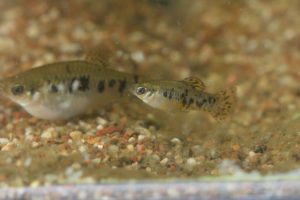
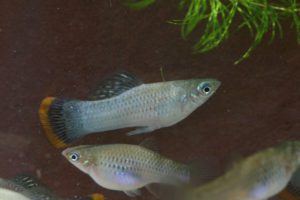
How did this particular female and possible hybrid come to be? Here’s the story. I had placed some juvenile Limia vittata in a vat to grow out. Apparently that vat had been housing Poecilia mexicana and someone (I blame anyone but me!) didn’t adequately clean the vat and left some P. mexicana fry in the vat. Due to reconstruction because of Hurricane Harvey (yeah, yeah, I know I blame everything on the storm!), that vat languished long enough for the fry to mature and produce fry that themselves matured. When we processed that vat, it was simple to sort out the P. mexicana and L. vittata except for this one female. In many ways, she seemed intermediate to the two species. While it’s difficult from the photo to tell, her coloration is similar to that of P. mexicana, down to the orangish caudal. But her body shape and head screams L. vittata.
While I’ve set her aside to see if she ever bears fry, she also encourages me to deliberately set up P. mexicana/L. vittata crosses. To do this properly, I should raise virgin females of both species and place them with males of the other species. Fat chance! That would require raising them in aquaria and using constant vigilance to remove developing males. First of all, we rarely raise fish in aquaria; we use vats on our large recirculating system. Aquaria require was too much maintenance such as water changes. We don’t have to do water changes on our recirculating system with plant filtration. Also raising virgins would require a few months for grow out. I’m a bit too impatient for that. So, what will I do? I’ll use brute force and simply set up two vats, one with P. mexicana males and L. vittata females and another with the reciprocal cross. Why both crosses? Just in case one pairing works and the other doesn’t. Now, those of you with experience with Poeciliidae (the family both species belong to) females will quickly see the problem with this approach: Limia and Poecilia females can store sperm and continue to produce fry from earlier matings. So, it can be difficult to tell if you are really getting hybrids. In this case, that doesn’t worry me because any fish resembling the above female will be hybrids. Another potential problem: it’s possible the males having mated with their own females might not pursue other species’ females. My experience with the males of both species makes that unlikely; they are both aggressive maters. And maybe the females will refuse to mate with the other species’ males…good luck with that, both species’ males are very persistent. I’ll probably set each vat up with a half dozen males and 40 females. Surely somebody will mate. After a few months I should know whether this will work. If it doesn’t either I’m right and the two species don’t hybridize, or I’ll have to bite the bullet and raise virgin females and try again.
Here’s the program I’ll use:
- Set up two 55-gallon breeding vats:
- One vat with 6 male mexicana and 40 female L. vittata.
- One vat with 6 male vittata and 40 female P. mexicana.
- After four weeks move breeding colonies to two new vats.
- Discard any fry in the original vats.
- Place a fry cage in each of the vats to provide cover for fry that might be potential hybrids.
- After about three months, remove the adults.
- After another two months, process the fry and segregate any possible hybrids.
The purpose of steps 2. and 3. is to purge fry the females were already carrying. Step 5. provides enough time for each female to go through three months of fertilization by the males from the other species. Step 6. allows the fry to mature enough to distinguish hybrids from non-hybrids resulting from prior fertilizations from the same-species males the females had been previously exposed to (I’m glad the rule against ending a sentence with a preposition is nearing extinction!). If the result is no hybrids, then I have to decide whether to abandon the project or to produce virgin females. If I decide to the produce virgins, I’ll also produce “virgin” males, males who have never seen mature females of their species just in case male preference for females is an issue.
By the way, you may have noticed the reference to a “fry cage” in step 4. We make these using aquaculture mesh. They are cylindrical with a mesh bottom and open to the top for feeding. We place one in each 55-gallon vat to provide shelter and refuge for fry. We also add Ceratophyllum demersum (hornwort) to each vat to provide cover for the fish and ammonia control (one of these days I’ll post my back of the envelope calculation of how much ammonia hornwort strips out of our systems daily).
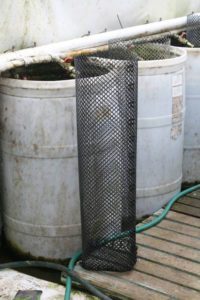
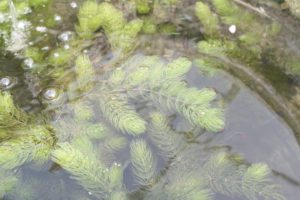
Ceratophyllum demersum (hornwort), a rootless floating plant in one of our vats.If you of you have experience with Limia/Poecilia hybrids, please let me know. If you have an opinion about the pictured potential hybrid, let me know.
Good Fishkeeping!

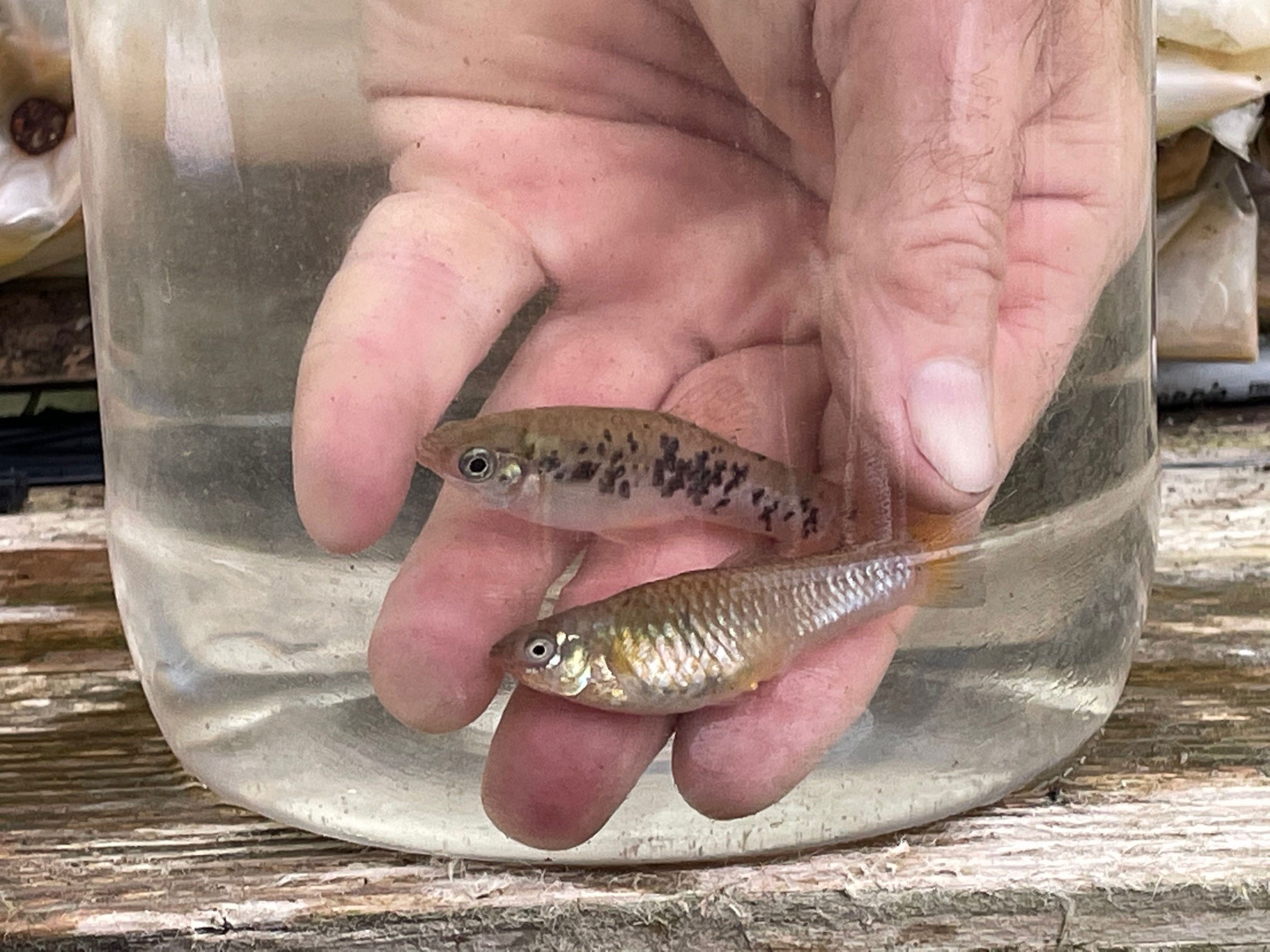
Akmal says
other then being Limia/Poecilia hybrids what else you think they could possibly be? just weird looking Limia? and what does your wife think of you using the precious vat space for this experiment, does she approve it’s usage?
Charles Clapsaddle says
Akmal,
Could be a weird Limia without dark markings. The body says it’s not a Poecilia mexicana.
Shhh!!! Susie (wife) doesn’t have to know everything!
Charles
Paul Kotarides says
Hi Charles – Very interesting! From our past correspondence you know I have an interest in livebearer hybrids. Good luck with this experiment- and I’ll keep an eye on your blog to hear about the results.
Speaking of why certain species hybridize, what constitutes a species – or even a genus- here is a weird example. Duck species are well known for their propensity for hybridization. Mallards are known to hybridize with many other species – even those way out of their genus spectrum. I’ve even heard of an eider x mallard hybrid. One odd thing is that mallards can and do hybridize with wood ducks – which are of a separate genus. However – wood ducks never seem to hybridize with their closest relative species which is in the same genus as wood ducks – the mandarin duck. They will mate in captivity ( their natural ranges don’t overlap) – but they don’t produce fertile eggs. It is thought they have incompatible chromosomes. So it goes to show you how complex the concept of what a species or genus really is when a duck can cross with a distant relative species – but not their closest relative in their own genus. Interesting stuff.
David says
There are a lot of interesting hybrids and supposed hybrids out there, for instance I’ve read and been told of hybrids between Gambusia and Guppies, but frankly I’ve never believed that was even possible, particularly since in more recent genetic phylogeny the genus Gambusia is much closer to the genus of Xiphophorus(and a couple others) than it is the guppies of Poecilia. But who knows, maybe there is still a chance it is possible?
It seems the whole of the Poeciliidae family still needs to be revised.
Charles Clapsaddle says
David, I also am skeptical about Gambusia/guppy hybrids. I’m certain we’ll see many revisions of Poeciliidae before it’s over.
Charles
Michael says
Charles,
Cudos for your originality in solving a breeding/segregation issue! I have come up with a quite similar use of materials for breeding and raising crayfish. I was pleasantly surprised to see someone else with a similar ingenuity. I do not use the drums anymore as I have found shallow water is much more preferable for crayfish. The drums await on our side yard hopefully will be used again for Tilapia raising and breeding… which actually worked but I was not satisfied with them as is. I Am developing a series of ponds which will be devoted to not only fish, but crayfish, our 7 “pet” turtles
(of three distinct genus raised from tiny hatchlings) edible plants and ornamental plants as well. The barrels will most likely be utilized for raising up fish fry and as an alternative for additional edible plants. Thought of even using one of them as a biological filter however I am convinced that this would be over-kill considering the way I am designing the whole system.
Charles Clapsaddle says
Michael,
Sorry about the very tardy reply. I didn’t know a bunch of messages were out there due to a computer upgrade.
Your setup sounds very interesting. I haven’t raised crayfish since I was a child, but am thinking about getting some of the more colorful ones and trying them. We have inadvertent “pet” redear sliders in the the greenhouses and two of our grandbrats (aka granddaughters) keep some in aquaria. One also has a pair of Axolotls.
Charles
Ryan Strait says
Yet another interesting project! Can’t wait to see how this one turns out and whether it the offspring would be fertile.
Charles Clapsaddle says
Ryan,
Sorry for the tardy reply.
So far no fry so I’m afraid the possible hybrid is sterile.
Charles
Michael Crowl says
A very interesting scenario indeed. While I read for scientific content, the joke about blame anyone but me was funny. I also enjoyed the jab at the lumpers and splitters. As aquaculture enthusiasts we all must follow those wretched nomenclature rules. It is always fun to challenge them as made famous in Jurassic Park, “nature will find a way “
Charles Clapsaddle says
Michael,
Sorry for the tardy reply.
I’m never at fault! I can’t be! Well…maybe…
It’s disheartening to have so many names changing. A favorite lizard genus of mine is Cnemidophorus, which some are trying to change to Aspidoscelis. But, so far, itis.gov hasn’t accepted those changes.
Charles
David says
I’ve heard and read of such crosses before, rare but possible apparently, and possibly fertile. This is pretty interesting to me because in my research I’ve found a few references in the past that Limia species have been found to able to hybridize and create fertile hybrids with both Mollies and P. reticulata guppies(with partial infertility reported in some of the F2s), which I found very intriguing as it might just possibly be a roundabout vector to move fancy guppy genes for coloration and/or fin form into a Limia and then perhaps ultimately a Molly line, or otherwise get more impressive tank strains of the various species. The direct Guppy-Molly hybrid mules are interesting to look at but seem to be a dead end, maybe this could be the detour around that limitation?
Unfortunately I wasn’t successful the last time I attempted to get a Limia perugiae breeding group going, my male was impressive, a real beauty and healthy but my females both died unexpectedly. Not easy to find nice L. perugiae I’ve found, there is a frequent seller on Aquabid purporting to sell Perugiae, but the unattractive example picture they have looks nothing like the shimmering beauty I know Perugiae can be(so perhaps misidentified?).
If you have a Molly-Limia hybrid there you’ve got something special, I certainly hope something interesting will come of it.
Charles Clapsaddle says
David,
So far no fry, so it doesn’t look promising. I think I’ll set up a couple of vats with reciprocals of Limia vittata and Poecilia mexicana (I should raise virgins, but to time consuming, so I hope any hybrids are very apparent). But that will have to wait since only 11 P. mexicana survived the 2021 Texas Winter Storm. I was a bit surprised at that since the species ranges into south Texas, but ours came from far south of there in Campeche.
We lost our L. perugiae in the Storm.
Charles
David says
Unfortunate to hear you lost your L. perugiae, all my fish and crayfish are inside but the Texas winter storm was indeed rough, it killed all my Kiwi vines and about a quarter of my young grape vines, and a few of my fruit trees, and even the surviving trees didn’t bloom much either so not a lot of fruit to speak of this year.
When I talked to Adrian Hernandez of Swamp River Aquatics a few years ago he did mention that the initial hybrids tended to resemble one or the other of the parents a lot, so keep a sharp eye out for those subtle differences (like the one you found). I believe he was using L. perugiae, P. sphenops, and P. reticulata at the time, though he didn’t seem particularly excited by them, saying “big bodies of poor (color) quality”, and saying he figured it would take several generations of crosses to get any real improvements, but maybe he is just hard to impress with the quality and bold showiness of his guppy strains though.
(L. perugiae X ‘Tiger’ Guppy): https://www.fishforums.net/proxy.php?image=http%3A%2F%2Fi24.photobucket.com%2Falbums%2Fc45%2FADRIANHD%2Ftest926.jpg&hash=6f3c9f74a040bd9aaf80e3ade995c962)
I’ve not had great luck crossing livebearers if they had access to other members of their own species in the tank, but maybe given a great enough numbers of chances like in the vats the odds will increase.
Charles Clapsaddle says
David, In addition to fish, we lost a few fruit trees. Some neighbors lost their decades old Meyer’s lemon trees that had survived earlier cold spells. Also, more than half of the area’s Washingtonia robusta, California fan palms, died in the storm. Many of those were older than me (I turned 71 a couple of days ago).
I’ve also noticed that when fish have their own species available they rarely hybridize even when kept with related species.
Charles
David says
Oh, and I forgot to mention before your initial specimen does look like a hybrid to me, the somewhat angular shape along the back reminds me of a Molly more than it does a Limia, now I’m not an expert but the Limia females I’ve seen have tended to have a little bit more curve to them along their backs.
Also, I’m of the opinion that Mollies, Limia, and Guppies should still be consigned each to a separate genus, and even so regardless of how successful we might be in forcing a rare cross between the wider groups.
Charles Clapsaddle says
David, I noted the same things you did. I also agree with you about mollies, Limias, guppies. I think Limias should remain in Limia. And that guppies and mollies should revert to their old genera, Lebistes and Mollienesia respectively,
Charles
Zoriah Mattern says
Any news on this one? A very interesting project whatever the outcome.
Charles Clapsaddle says
Zoriah, Unfortunately, she didn’t make it. I should set up some test crosses with virgin females.
Charles
Melissa says
This comment is quite late compared to the post, but I am wondering if there was any update on this experiment? I also because I have a possible Limia perugaie x Characadon lateralis cross. I find it unlikely that they can cross, but I clearly have fry similar to the limia in a tank with only one male Limia and both sexes of Characadon lateralis (to my knowledge.) I am wondering if I may have missed a sneaky, small female. Thanks for any updates you can provide!
Charles Clapsaddle says
Melissa, First, sorry for the tardy reply. Your message just popped up. That female passed on without fry. I haven’t seen any certain hybrids and haven’t set up any test crosses.
Charles